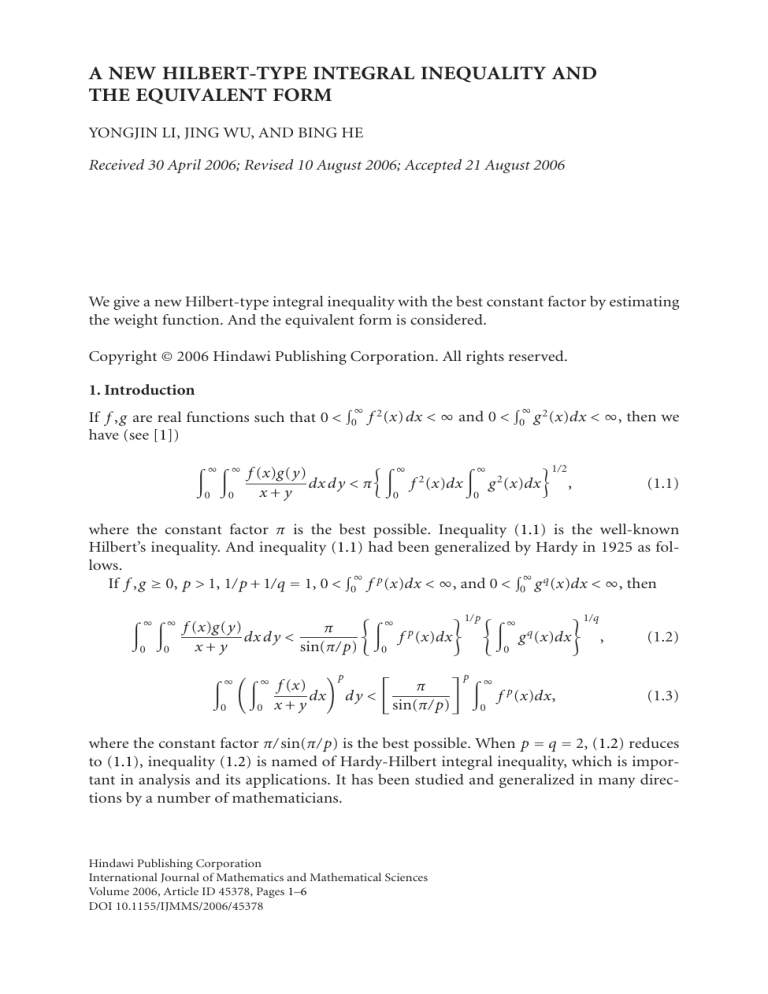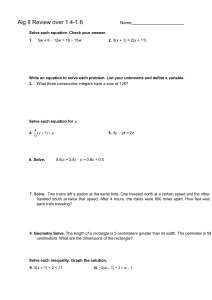
A NEW HILBERT-TYPE INTEGRAL INEQUALITY AND
THE EQUIVALENT FORM
YONGJIN LI, JING WU, AND BING HE
Received 30 April 2006; Revised 10 August 2006; Accepted 21 August 2006
We give a new Hilbert-type integral inequality with the best constant factor by estimating
the weight function. And the equivalent form is considered.
Copyright © 2006 Hindawi Publishing Corporation. All rights reserved.
1. Introduction
If f ,g are real functions such that 0 <
have (see [1])
∞∞
0
0
∞
0
f 2 (x)dx < ∞ and 0 <
f (x)g(y)
dx d y < π
x+y
∞
0
f 2 (x)dx
∞
0
∞
0
g 2 (x)dx < ∞, then we
1/2
g 2 (x)dx
,
(1.1)
where the constant factor π is the best possible. Inequality (1.1) is the well-known
Hilbert’s inequality. And inequality (1.1) had been generalized by Hardy in 1925 as follows.
∞
∞
If f ,g ≥ 0, p > 1, 1/ p + 1/q = 1, 0 < 0 f p (x)dx < ∞, and 0 < 0 g q (x)dx < ∞, then
∞∞
0
0
f (x)g(y)
π
dx d y <
x+y
sin(π/ p)
∞ ∞
0
0
f (x)
dx
x+y
p
dy <
∞
0
1/ p f p (x)dx
π
sin(π/ p)
∞
0
p∞
0
1/q
g q (x)dx
f p (x)dx,
,
(1.2)
(1.3)
where the constant factor π/ sin(π/ p) is the best possible. When p = q = 2, (1.2) reduces
to (1.1), inequality (1.2) is named of Hardy-Hilbert integral inequality, which is important in analysis and its applications. It has been studied and generalized in many directions by a number of mathematicians.
Hindawi Publishing Corporation
International Journal of Mathematics and Mathematical Sciences
Volume 2006, Article ID 45378, Pages 1–6
DOI 10.1155/IJMMS/2006/45378
2
A new Hilbert-type integral inequality
In this paper, we give a new type of Hilbert’s integral inequality as follows:
∞∞
0
0
f (x)g(y)
dx d y < c
x + y + max{x, y }
√
∞
0
f 2 (x)dx
∞
0
1/2
g 2 (x)dx
,
(1.4)
√
where c = 2(π − 2arctan 2) = 1.7408 ....
2. Main results
Lemma 2.1. Suppose ε > 0, then
∞
1
x −ε −1
x−1
0
1
t (−1−ε)/2 dt dx = O(1) ε → 0+ .
1 + t + max{1,t }
(2.1)
Proof. There exists n ∈ N which is large enough, such that 1 + (−1 − ε)/2 > 0 for ε ∈
(0,1/n], we have
x−1
0
1
t (−1−ε)/2 dt <
1 + t + max{1,t }
x−1
t
0
(−1−ε)/2
1+(−1−ε)/2
1
1
dt =
1 + (−1 − ε)/2 x
.
(2.2)
Since for a ≥ 1 the function g(y) = 1/ ya y (y ∈ (0, ∞)) is decreasing, we find
1+(−1−ε)/2
1
1
1 + (−1 − ε)/2 x
≤
1+((−1−1)/n)/2
1
1
1 + (−1 − 1)/n /2 x
,
(2.3)
so
∞
0<
1
∞
<
1
x −ε −1
x −1
=
x−1
0
1
t (−1−)/2 dt dx
1 + t + max{1,t }
1+((−1−1)/n)/2
1
1
1 + (−1 − 1)/n /2 x
(2.4)
dx
2
1
.
1 + (−1 − 1)/n /2
Hence the relation (2.1) is valid. The lemma is proved.
Now we study the following inequality.
Theorem 2.2. Suppose f (x), g(x) ≥ 0, 0 <
∞∞
0
0
∞
0
f (x)g(y)
dx d y < c
x + y + max{x, y }
√
√
f 2 (x)dx < ∞, 0 <
∞
0
f 2 (x)dx
∞
0
∞
0
g 2 (x)dx < ∞. Then
1/2
g 2 (x)dx
,
where the constant factor c = 2(π − 2arctan 2) = 1.7408 ... is the best possible.
(2.5)
Yongjin Li et al. 3
Proof. By Hölder’s inequality, we have
∞∞
0
0
=
f (x)g(y)
dx d y
x + y + max{x, y }
∞∞
0
∞∞
0
×
1/4
g(y)
x + y + max{x, y }
y
x
1/2
dx d y
(2.6)
1/2
f 2 (x)
x
x + y + max{x, y } y
0
∞∞
0
x
y
1/2
x + y + max{x, y }
0
×
≤
1/4
f (x)
dx d y
1/2
g 2 (y)
y
x + y + max{x, y } x
0
dx d y.
Define the weight function (u) as
(u) :=
∞
0
1/2
1
u
u + v + max{u,v} v
dv,
(2.7)
then the above inequality yields
∞∞
0
0
≤
f (x)g(y)
dx d y
x + y + max{x, y }
∞
0
1/2 ∞
2
(x) f (x)dx
0
(2.8)
1/2
2
(y)g (y)d y
.
For fixed u, let v = ut, we have
(u) :=
=
=
∞
0
1
0
√
1/2
1
1
1 + t + max{1,t } t
∞
1/2
1 1
2+t t
dt +
√
1
dt
1/2
1
1
1 + 2t t
(2.9)
dt
2(π − 2arctan 2).
Thus
∞∞
0
f (x)g(y)
dx d y
x + y + max{x, y }
0
≤
√
√ ∞
2(π − 2arctan 2)
0
f 2 (x)dx
1/2 ∞
0
(2.10)
1/2
g 2 (x)dx
.
4
A new Hilbert-type integral inequality
If (2.10) takes the form of the equality, then there exist constants a and b, such that
they are not all zero and
1/2
a
f 2 (x)
x
x + y + max{x, y } y
1/2
=b
y
g 2 (y)
x + y + max{x, y } x
(2.11)
a.e. on (0, ∞) × (0, ∞).
Then we have
ax f 2 (x) = byg 2 (y) a.e. on (0, ∞) × (0, ∞).
(2.12)
Hence we have
ax f 2 (x) = byg 2 (y) = constant = d
a.e. on (0, ∞) × (0, ∞).
(2.13)
Without losing the generality, suppose a = 0, then we obtain f 2 (x) = d/ax, a.e. on
∞
(0, ∞), which contradicts the fact that 0 < 0 f 2 (x)dx < ∞. Hence (2.10) takes the form
of strict inequality; we get (2.5).
For 0 < ε < 1, set fε (x) = x(−ε−1)/2 , for x ∈ [1, ∞); fε (x) = 0, for x ∈ (0,1). gε (y) =
(
−ε−1)/2
y
, for y ∈
[1, ∞); gε (y) = 0, for y ∈ (0,1). Assume that the constant factor c =
√
√
2(π − 2arctan 2) in (2.2) is not the best possible, then there exists a positive number
K with K < c, such that (2.5) is valid by changing c to K. We have
∞∞
0
f (x)g(y)
dx d y < K
x + y + max{x, y }
∞
1/2 ∞
1/2
K
,
ε
(2.14)
√
√
1
t (−1−ε)/2 dt = 2(π − 2arctan 2) + o(1) (ε −→ 0+ ).
1 + t + max{1,t }
(2.15)
0
0
f 2 (x)dx
0
g 2 (x)dx
=
since
∞
0
Setting y = tx, by (2.1), we find
∞∞
0
0
=
=
=
=
f (x)g(y)
dx d y
x + y + max{x, y }
∞∞
1
1
∞∞
x−1
1
∞
1
x(−ε−1)/2 (tx)(−ε−1)/2
dx dt
1 + t + max{1,t }
x −ε −1
1 √
ε
x(−ε−1)/2 y (−ε−1)/2
dx d y
x + y + max{x, y }
∞
0
1
t (−1−ε)/2 dt −
1 + t + max{1,t }
√
x−1
0
1
t (−1−ε)/2 dt dx
1 + t + max{1,t }
2(π − 2arctan 2) + o(1) .
(2.16)
Yongjin Li et al. 5
Since, for ε > 0 small enough, we have
√
√
2(π − 2arctan 2) + o(1) < K,
√
(2.17)
√
thus we get 2(π − 2arctan 2) ≤ K, then c ≤ K, which contradicts the hypothesis. Hence
the constant factor c in (2.5) is the best possible.
Theorem 2.3. Suppose f ≥ 0 and 0 <
∞ ∞
0
0
∞
0
f 2 (x)dx < ∞. Then
2
f (x)
dx d y < c2
x + y + max{x, y }
∞
f 2 (x)dx,
0
(2.18)
√
where the constant factor c2 = 2(π − 2arctan 2)2 = 3.0305 ... is the best possible. Inequality
(2.18) is equivalent to (2.5).
Proof. Setting g(y) as
∞
0
f (x)
dx,
x + y + max{x, y }
y ∈ (0, ∞),
(2.19)
then by (2.5), we find
∞
0<
=
=
≤
0
g 2 (y)d y
∞ ∞
0
0
∞∞
0
0
2
f (x)
dx d y
x + y + max{x, y }
(2.20)
f (x)g(y)
dx d y
x + y + max{x, y }
√ ∞
√
2(π − 2arctan 2)
0
f 2 (x)dx
1/2 ∞
0
1/2
g 2 (y)d y
.
Hence we obtain
∞
0<
0
√
g 2 (y)d y ≤ 2(π − 2arctan 2)2
∞
0
f 2 (x)dx < ∞.
(2.21)
By (2.5), both (2.20) and (2.21) take the form of strict inequality, so we have (2.18).
On the other hand, suppose that (2.18) is valid. By Hölder’s inequality, we find
∞∞
0
0
=
≤
f (x)g(y)
dx d y
x + y + max{x, y }
∞ ∞
0
0
∞ ∞
0
f (x)
dx g(y)d y
x + y + max{x, y }
0
2
f (x)
dx d y
x + y + max{x, y }
1/2 (2.22)
∞
0
1/2
g 2 (y)d y
Then by (2.18), we have (2.5). Thus (2.5) and (2.18) are equivalent.
.
6
A new Hilbert-type integral inequality
√
If the constant c2 = 2(π − 2arctan 2)2 in (2.18) is not the best possible, by (2.22), we
may get a contradiction that the constant factor c in (2.5) is not the best possible. Thus
we complete the proof of the theorem.
Acknowledgment
The authors would like to thank the anonymous referees for their suggestions and corrections.
References
[1] G. H. Hardy, J. E. Littlewood, and G. Pólya, Inequalities, Cambridge University Press, Cambridge, 1952.
Yongjin Li: Department of Mathematics, Sun Yat-Sen University, Guangzhou 510275, China
E-mail address: stslyj@mail.sysu.edu.cn
Jing Wu: Department of Statistics, Sun Yat-Sen University, Guangzhou 510275, China
E-mail address: wjjosie@hotmail.com
Bing He: Department of Mathematics, Sun Yat-Sen University, Guangzhou 510275, China
E-mail address: hzs314@163.com









